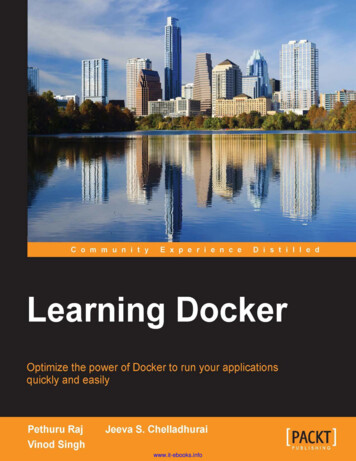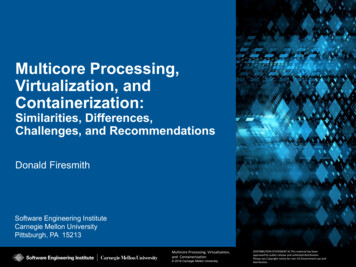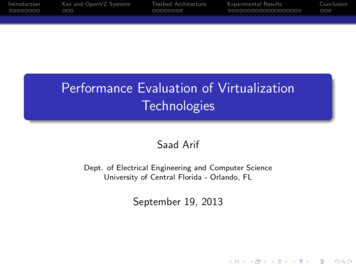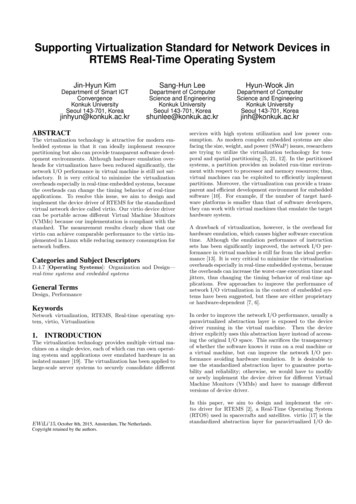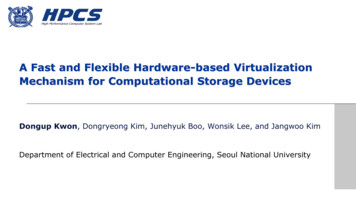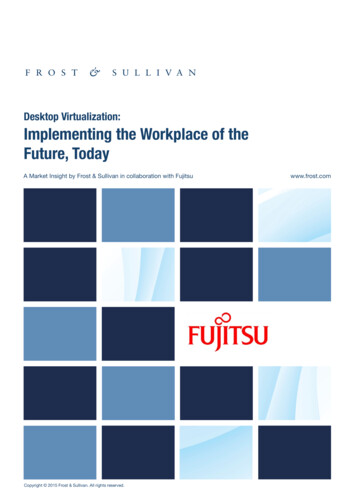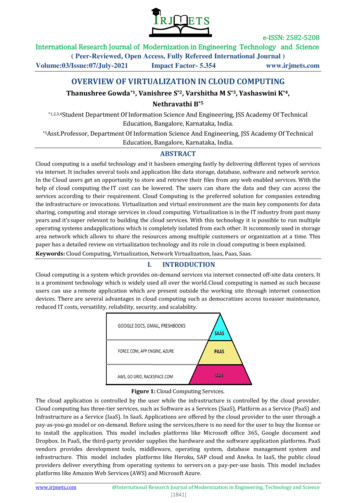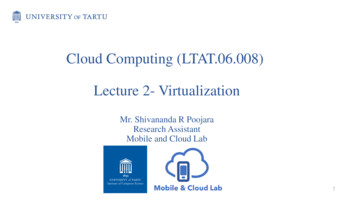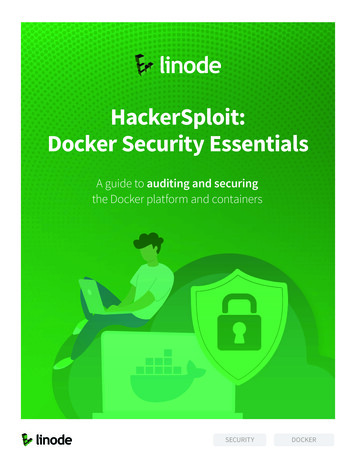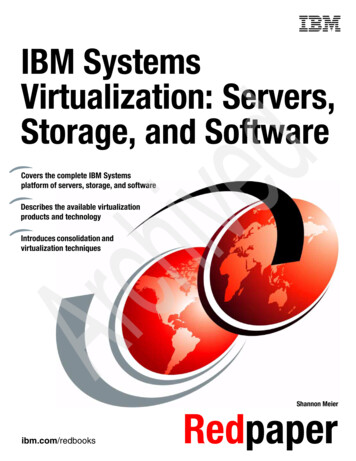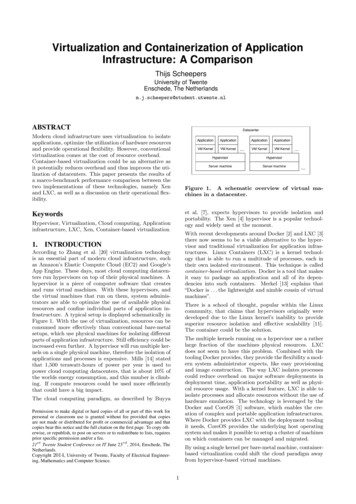
Transcription
Virtualization and Containerization of ApplicationInfrastructure: A ComparisonThijs ScheepersUniversity of TwenteEnschede, The TModern cloud infrastructure uses virtualization to isolateapplications, optimize the utilization of hardware resourcesand provide operational flexibility. However, conventionalvirtualization comes at the cost of resource overhead.Container-based virtualization could be an alternative asit potentially reduces overhead and thus improves the utilization of datacenters. This paper presents the results ofa marco-benchmark performance comparison between thetwo implementations of these technologies, namely Xenand LXC, as well as a discussion on their operational flexibility.Figure 1. A schematic overview of virtual machines in a datacenter.et al. [7], expects hypervisors to provide isolation andportability. The Xen [4] hypervisor is a popular technology and widely used at the moment.KeywordsHypervisor, Virtualization, Cloud computing, Applicationinfrastructure, LXC, Xen, Container-based virtualization1.With recent developments around Docker [2] and LXC [3]there now seems to be a viable alternative to the hypervisor and traditional virtualization for application infrastructures. Linux Containers (LXC) is a kernel technology that is able to run a multitude of processes, each intheir own isolated environment. This technique is calledcontainer-based virtualization. Docker is a tool that makesit easy to package an application and all of its dependencies into such containers. Merkel [13] explains that“Docker is . . . the lightweight and nimble cousin of virtualmachines”.INTRODUCTIONAccording to Zhang et al. [20] virtualization technologyis an essential part of modern cloud infrastructure, suchas Amazon’s Elastic Compute Cloud (EC2) and Google’sApp Engine. These days, most cloud computing datacenters run hypervisors on top of their physical machines. Ahypervisor is a piece of computer software that createsand runs virtual machines. With these hypervisors, andthe virtual machines that run on them, system administrators are able to optimize the use of available physicalresources and confine individual parts of application infrastructure. A typical setup is displayed schematically inFigure 1. With the use of virtualization, resources can beconsumed more effectively than conventional bare-metalsetups, which use physical machines for isolating differentparts of application infrastructure. Still efficiency could beincreased even further. A hypervisor will run multiple kernels on a single physical machine, therefore the isolation ofapplications and processes is expensive. Mills [14] statedthat 1,500 terawatt-hours of power per year is used topower cloud computing datacenters, that is about 10% ofthe worlds energy consumption, and this number is climbing. If compute resources could be used more efficientlythat could have a big impact.There is a school of thought, popular within the Linuxcommunity, that claims that hypervisors originally weredeveloped due to the Linux kernel’s inability to providesuperior resource isolation and effective scalability [11].The container could be the solution.The multiple kernels running on a hypervisor use a ratherlarge fraction of the machines physical resources. LXCdoes not seem to have this problem. Combined with thetooling Docker provides, they provide the flexibility a modern system administrator expects, like easy provisioningand image construction. The way LXC isolates processescould reduce overhead on major software deployments indeployment time, application portability as well as physical resource usage. With a kernel feature, LXC is able toisolate processes and allocate resources without the use ofhardware emulation. The technology is leveraged by theDocker and CoreOS [1] software, which enables the creation of complex and portable application infrastructures.Where Docker provides LXC with the deployment toolingit needs, CoreOS provides the underlying host operatingsystem and makes it possible to setup a cluster of machineson which containers can be managed and migrated.The cloud computing paradigm, as described by BuyyaPermission to make digital or hard copies of all or part of this work forpersonal or classroom use is granted without fee provided that copiesare not made or distributed for profit or commercial advantage and thatcopies bear this notice and the full citation on the first page. To copy otherwise, or republish, to post on servers or to redistribute to lists, requiresprior specific permission and/or a fee.21st Twente Student Conference on IT June 23rd , 2014, Enschede, TheNetherlands.Copyright 2014, University of Twente, Faculty of Electrical Engineering, Mathematics and Computer Science.By using a single kernel per bare-metal machine, containerbased virtualization could shift the cloud paradigm awayfrom hypervisor-based virtual machines.1
Table 1. Virtualization iner-basedLXCOpenVZVServerLXC differs in a lot of ways from the traditional hypervisor. This paper will focus on two differences: physicalresource impact and operational flexibility. This paper isstructured as follows:In Section 2 we will elaborate on the working of the Xenhypervisor, LXC, Docker and CoreOS. Next, in Section 3we discuss related work and the contribution of this paper.Figure 2. A schematic overview of a machine running the Xen hypervisor.We will compare the physical performance of a single machine, running the same application using two differentisolation techniques. Namely, isolation through virtualization and through containerization. Do containers really have a performance benefit, and if so, how significantis that benefit? These questions will be answered in Section 4 by analyzing the results of several benchmarks.virtual machine on the Xen hypervisor could run a modified kernel in order to provide better performance andreduce overhead. The hypervisor is installed directly intothe bootloader.The virtual machines, running on top of the hypervisor,are called domains or guests. A special domain, calleddomain0, controls the system (Dom0). This domain hasthe capability to setup the environment. It could containtools for the setup of networking, provisioning of new virtual machines and migrating them.There are still several research challenges when talkingabout cloud computing. Among others, improving automated service provisioning, machine migrations and serverconsolidation [20]. In Section 5, we discuss these and showhow Xen and Docker are able to help with these challengesand how their solutions differ.The other domains are what is called underprivileged todomain0. Therefore they are called DomU. These DomUdomains can either be para-virtualized (PV) or hardwareassisted (HVM). The PV-domains require a optimized kernel, whereas the HVM-domains require no kernel modification but do require x86’s virtualization support (IntelVT-X, AMD-SVM). This architecture support is not required when running a PV virtual machine.Finally, in Section 6 the results of the performance comparison as well as the operational comparison will be discussed and related.2.BACKGROUNDModern application infrastructure techniques and methodologies incentivize an accelerated adoption of cloud computing technologies as well as various virtualization technologies. For example the DevOps [10] software development methodology and techniques that require scriptableinfrastructure.Since Xen only provides the hypervisor technology, westill need a management operating system to be installedon Dom0. The XenServer is an implementation for theDom0 management system. It provides extended toolingto provision, manage, monitor and migrate virtual machines. This is the domain on which XenServer could beinstalled. With domain0 being a virtual environment, aXenServer installation is itself running on a virtual machine. Figure 2 shows a schematic overview of a machinerunning the Xen hypervisor with XenServer installed onDom0.The virtualization technologies that have emerged mostlyfocus on the Linux kernel and can be split up into threecategories: full-virtualization, para-virtualization andcontainer-based virtualization. Para-virtualization modifies the kernel of virtual machines slightly to optimize forperformance in the virtual environment. Full-virtualizationdoes not require kernel adjustments. Container-based virtualization does not use a kernel at all.Xen has been in development for more than 12 years andthus can be considered a mature technology. Xen technology is widely used, for example by Amazone Web Services,Google, Rackspace, Oracle, Cisco and Citrix [5].Table 1 shows a selection of various technologies and theircategorization. These are the kind of technologies used inIaaS (infrastructure as a service) solutions and PaaS (platform as a service) solutions like Amazone Elastic ComputeCloud, Google App Engine, DotCloud and Open Shift.Since application infrastructure can be diverse, there is nosingle best solution for all of these services. Rather, eachservice or application has its own specific requirements.2.2We will be comparing two different technologies with a different architectures: Xen, a para-virtualization hypervisorand LXC, a container-based isolation linux kernel feature.In this section we will briefly explain both architectures.In the following sections we will go in depth on their performance and operational flexibility.2.1LXCLinux Containers (LXC) provides lightweight operatingsystem virtualization and is relatively new to the othertechnologies listed in Table 1. Unlike Xen, LXC does notrequire hardware architecture support. LXC is the successor of VServer and OpenVZ, other container-based virtualization technologies.The basic principle of a container is that it allows forprocesses and their resources to be isolated without anyhardware emulation or hardware requirements. Containers provide a sort of virtualization platform where everycontainer can run their own operating system but sharethe kernel. So each container has their own filesystem andXenThe Xen hypervisor is based on para-virtualization. A2
modern infrastructure stacks. The distribution provides atrimmed down Linux kernel to reduce as much overheadas possible.CoreOS also provides the fleet and etcd tools with which acluster could be setup to provide redundancy and failover.2.2.3FutureBoth Docker and CoreOS are still in active developmentand have not reached a stable release. Both projects currently recommend not to use the systems in productionenvironments.LXC already has a stable release but new features are stillin development. There are plans to add new namespacesto enhance isolation and security. These include a securitynamespaces, device namespaces and time namespaces. Especially the time namespace is an interesting development,since it will allow for live host migrations.Figure 3. A schematic overview of a machine running the CoreOS and LXC containers.Combining LXC with Docker and CoreOS, the whole package provides a lightweight, clean, full featured base layerfor isolating application infrastructure.network stack, and every container can run its own Linuxdistribution. For example, a CoreOS host can run Ubuntu,RHEL, Debian, Arch and even other CoreOS containerssimultaneously. These abstractions make a container behave like virtual machine with a separate filesystem, networking and other operating system resources. But reallythey are not, since there is no hardware emulation takingplace. Figure 3 shows a schematic overview of a machinerunning the CoreOS and two LXC containers.3.Ever since IBM first introduced the idea, virtualizationhas been a well-covered research topic, especially virtualization for the x86 architecture. There have been severalpapers comparing various virtualization technologies:Isolation is an important aspect of containers, it is provided through Linux cgroups and namespaces. Namespaces are used to isolate resources like; the filesystem, networking, user management and process ids. Cgroups areused for resource allocation and management. For example with a cgroup the amount of memory, a container canuse, can be limited. Cgroups are regular Linux processgroups so they can run next to any host OS processes.One important difference in resource allocation betweenLXC and hypervisors is that CPU resources can not beallocated on a per core basis, rather one should specify apriority.2.2.1Quétier et al. [15] compared VServer container technology with Xen, UML and VMWare on their ability to scaleand provide resource isolation. They found that VMWareand UML have strong limitations with respect to overheadand performance isolation. They also found that Xen suffers from slow inter-virtual machine communication performance.Che et al. [8] compared micro- and macro-performance ofthe Xen, KVM and OpenVZ technology. OpenVZ is apredecessor of LXC and is also based around containerbased isolation.DockerDocker is a tool that makes it easy to package an application and all of its dependencies into a container. It doesthis by providing a toolset and an unified API for managing kernel-level technologies, such as LXC containers,cgroups and a copy-on-write filesystem.Wang and Ng [17] presented a measurement study to characterize the impact of virtualization on the networkingperformance of the Amazon Elastic Cloud Computing,which uses Xen. It was found that even when the networkwas lightly used, virtualization could introduce significantdelay variation and throughput instability.Docker relies on AuFS (Advanced Multi-Layered Unification Filesystem) as a filesystem for containers. AuFS isa layered filesystem that can transparently overlay one ormore existing filesystems. AuFS allows Docker to use certain images as the basis for containers. For example, youmight have an Ubuntu image that can be used as the basis for many different containers. Thanks to AuFS, onlyone copy of the Ubuntu image is required, which resultsin savings in storage space and memory consumption, aswell as the faster deployment of containers. Another benefit of using AuFS is the ability to version images. Eachnew version is simply a diff 1 of changes from the previousversion, effectively keeping image files to a minimum. Thisalso means that there always is a complete audit trail ofwhat has changed from one version of a container to another, just like version control systems used in softwaredevelopment[13].2.2.2RELATED WORKVirtualization was first introduced in the 1960s by researchers at IBM. The system, IBM developed, has evolvedand is currently still being used in their z/VM hypervisorfor the IBM System Z mainframe.Bardac et al. [6] used LXC to deploy a large scale peerto-peer BitTorrent network. Host resource analysis andswarm performance analysis were performed for multipleswarm configurations. The experiment allowed the identification of several correlations between virtualization parameters, such as the influence of uplink traffic shaping ondownload capacity and the relation between host switching capacity and CPU utilization.Younge et al. [19] evaluated virtualization technologies inthe context of HPC (High performance computing): Xen,KVM and VirtualBox were compared. It was concludedthat KVM is the best overall choice for HPC since the researchers found that KVM performed significantly betterthan Xen and VirtualBox in the HPCC[12] and SPEC[9]benchmarks.CoreOS1Diff is a file comparison utility that outputs the differences between two filesCoreOS is a relatively new Linux distribution that hasbeen architected to provide features needed to run large3
Xavier et al. [18] did similar research on virtualizationin HPC environments. However, he focused solely oncontainer-based technologies: LXC, OpenVZ and VServer.The study found that the resource isolation features incontainer-based systems are not mature, yet. Performanceon memory and network isolation was poor, CPU on theother hand was isolated well. Disk I/O performance wasnot measured.Sampathkumar [16] did a comprehensive study where hecompared LXC with Xen as well as KVM. This was donein order to find the optimal technology to be used in theIntelligent River middleware system. He did several microbenchmarks measuring performance in CPU, memory anddisk I/O. However, networking was outside of the scope ofhis research, as was the use of deployment and management software. All the software was installed with Ubuntuas the host operating system. One could argue that thisdoes not do the specific technologies justice, since everytechnology runs better on a Linux distribution tailored toits needs. The research found that Xen was far betteron isolating resources but at the cost of adding overhead.LXC, on the other hand, was more performant when looking at disk I/O, RAM as well as CPU. In the end, theadvice was in favor of LXC technology.3.1Figure 4. The total amount of requests processedwithin 800 seconds. (More is better)ContributionMost of these studies draw their conclusions from microbenchmarks and focus on the core of the virtualizationtechnologies—like the hypervisor. Micro-benchmarks arebenchmarks which focus on a single isolated component.For example the time the PHP interpreter takes to executea certain algorithm. Macro-benchmarks on the other handare benchmarks that focus on interconnected components,like an application’s infrastructure as a whole.The real difference in virtualization technologies can oftenbe found in the way virtual machines communicate withone another, and how load on a specific virtual machineinfluences the other. The performance benchmarks described in this paper are macro-benchmarks. We look atnetwork latency when virtual machines are communicatingwith one another and take the deployment infrastructureinto account.Figure 5. Progression of the request time for thefirst 600 seconds. (Less is better)Virtual machines do not live on their own, they live withinapplication infrastructure and perform their designatedtask. This infrastructure could built on a cluster of physical machines for example all running CoreOS or XenServer.These low level software implementations are the core onwhich a cloud computing datacenter is built. The development of Docker has made the use of LXC considerablyeasier.We will measure the performance of both technologies running on software tailored to their needs and we will discussoperational flexibility, which is essential to system administrators. This is different from previous work since welook at the application infrastructure as a whole and taketooling into account. This instead of performing microbenchmarks, which are performed on host operating systems which are not used in real production environments,since they are not tailored to the specific technology.4.PERFORMANCE COMPARISONFigure 6. Progression of the request time for 800seconds. (Less is better)In order to compare Xen with LXC we have setup XenServer6.2 and CoreOS 324.3.0 with Docker 0.11.1 on two identical machines. They are equipped with 4GB of RAM andan Intel Xeon Quad core CPU with Intel VT-X virtualization support. Both will run two Ubuntu 12.04 virtualmachines or containers.4
The virtual machines running on the XenServer host usea para-virtualized kernel and have XenServer Tools installed for further optimization through drivers especiallydesigned for running on Xen. On Xen both virtual machines get access to two CPU cores.The first virtual machine gets access to 2 GB of memory and runs Apache 2.2, PHP 5.3 and WordPress 3.9.It functions as an application server. The second virtualmachine gets access to 1 GB of memory and runs MySQL5.5 with a database filled with the default sample contentWordPress provides. This machine functions as databaseserver. With these technologies we run an installation ofWordPress on the LAMP application stack with separateapplication and database servers.Figure 7. Time in ms to complete a one SQL SELECT query. (Less is better)Two separate benchmarks have been performed, the firstbenchmark focused on the application’s performance whenit is used by an increasing number of users. The secondbenchmark focused specifically on the interaction betweenthe two machines.when it has physical memory available.For the first benchmark, we used JMeter to generate alarge number of simultaneous requests. Using top2 , NewRelicserver monitoring and XenServer software the performanceon the host system will be monitored.4.1Application benchmarkThe application test is a macro-benchmark. Our application setup will present a WordPress blog filled with the default sample content provided with the installation. Whena request is made to the blog, the WordPress softwareneeds to fetch data from the database and return with aresponse. We will use JMeter to send an increasing number of simultaneous requests. We use an increasing number to know on with number of simultaneous requests theserver runs out of memory and start experiencing severeperformance problems.When the number of connections increased beyond whatthe server could handle with physical memory, the hoststarts swapping memory between its hard disk and physical memory—Figure 6 clearly shows this effect. After 610seconds (85 concurrent connections) the Xen setup startsthis process. And after 655 seconds (91 concurrent connections) the LXC setup runs out of memory. This meansthat the memory overhead Xen introduces, in respect toLXC, could be used to process 6 more concurrent requestswith LXC.Furthermore Figure 6 shows that LXC handles the thrashing more consistently. However, Xen is able to continueserving the responses faster and with less failed responses.Failed responses are identified using HTTP status codes,for example 502 Bad Gateway. The downward slope after700 seconds is caused by failed requests, since the graphonly shows successful requests. After 707 seconds the application running on LXC starts to throw errors. This isexpected since Sampathkumar [16] has already shown thatXen is considerably better at isolating than LXC. In particular, in situations where the required resources exceedthe available ones.Within 800 seconds JMeter attempted to perform as manyrequests as it could, with an increasing amount of concurrent requests. Only requests which resulted in a successfulresponse were counted. At t 0ms the testing softwarestarted with 1 concurrent request and would send a newrequest once the previous finished. The number of concurrent requests was increased linearly, until at 720 secondsit reached 100 concurrent requests.In this benchmark we did not give the containers accessto the surplus of memory, the difference in host operating system footprint provided. The basic footprint of aclean setup for XenServer used 906MB memory for running the domain0 virtual machine. If we compare this to161MB footprint of a clean CoreOS installation, the difference would be 745MB, which could be used for handlingadditional requests.One of the purposes of this benchmark was to check whensignificant performance loss, due to resource shortage, wouldhappen.Figure 4 shows the number of requests that were successful within 800 seconds. The figure shows that CoreOSwas able to process far more requests within the 800 seconds, more than four times as many as Xen. This was unexpected since Sampathkumar [16] showed, in his microbenchmarks, that LXC outperformed Xen by 7% not by306%. This difference could be attributed to the different ways CPU isolation is handled, where Xen isolates perCPU core, LXC uses isolation based on cgroup priority.With this LXC could be able to use the available CPUresources more effectively and we think this could be thecause of this difference.4.2Inter-virtual machine communicationbenchmarkIn order to test inter-virtual machine communication witha real world application stack we performed two morebenchmarks. The first was a PHP-script querying thedatabase to test inter-virtual machine communication. Thescript was executed on a different virtual machine than thedatabase. The results are shown in Figure 7. These showthat LXC experiences less overhead when querying thedatabase. This overhead consists of overhead in networking and CPU utilization, since these are the main resourcesconsumed by running this benchmark. The results corresponds with the conclusion of Wang and Ng [17] whichstates that the virtual networking used with Xen introduces overhead.Figure 5 shows that Xen takes more time to process asingle request. The trend line drawn in-between the datapoints takes the average of 30 data points. A flatter linesuggests a more consistent performance. So Figure 5 showsthat Xen does not perform as consistently as LXC, even2Top is an activity monitor utility for Unix, similar to theWindows task manager.A far more interesting benchmark is the performance ofinter-virtual machine communication under stress. With5
Table 2. Oparational flexibility comparisonTechnology footprintImage creationService discoveryCluster configurationHigh availabiltyStartup timeMachine migrationCoreOS 0 -XenServer00 0 EC2N/A0 0 vious image, effectively keeping image files to a minimum.Figure 8. Time in ms to complete 10.000 SQLINSERT queries. (Less is better)The Dockerfile enables branching of images, since everyresulting image can serve as a new base image for a newDockerfile. For example, you could have an ubuntuessentials image which contains monitoring software.An ubuntu-application image and an ubuntu-databaseimage could both use the same ubuntu-essentials imageas base image. This adds flexibility but also enables rapidimage creation.another PHP-script, we will be inserting randomly generated data into the database. The script was set up sothat the generation of the data utilized all the availableresources. Figure 8 shows that the same script took 16seconds to complete on the Xen setup. While it took 335seconds on the LXC setup. This clearly shows LXC’s inability to successfully isolate resources.XenServer and IaaS solutions provide snapshots as well asimages. But these can not easily be constructed from asingle script and duplicate the entire image data. Therefore one could argue that Docker provides a better formatfor image creation.With the results of these benchmarks we can confirm thatthe conclusions of Sampathkumar [16] and Wang and Ng[17] still hold in the environments tailored to the specifictechnologies. However, the difference in resource isolationability and overhead reduction seem to be more extreme.5.5.2OPERATIONAL COMPARISONWhile optimal performance and stability is a noble goal,we believe that ease of use and performant tooling is equallyas important. Especially since the rise of the new DevOps[10] software development methodology, which encouragesthe use of scripting and automation when designing application infrastructure. The use of virtualization and thedevelopment of infrastructure APIs has enabled this.IaaS solutions that use Xen like EC2 use metadata services, which every virtual machine can access by sending an HTTP request to a specific URL. XenServer itselfdoes not support this out-of-the-box. This does not haveto be a problem, since one could architect infrastructurethat leverarges service discovery without an out-of-the-boxmetadata service. However, a metadata service does provide an easier solution.Both LXC and Xen have various tooling options and couldbe used to automate deployment and design infrastructure. However, how these tools work differs. Table 2shows how we have judged various components of the tooling. The table distinguishes between CoreOS, which usesDocker and LXC, XenServer and Amazone’s EC2, whichalso uses Xen and provides virtual machines as a publiccloud service. EC2 has other, and in some cases morecomprehensive, tooling options than XenServer. We willdiscuss each component.CoreOS uses a metadata service called etcd. The serviceruns on the host machine and can be clustered. Correctclustering does require some configuration. Our experience is that debugging a wrongly configured cluster is notalways convenient. Since CoreOS has not reached a production ready state we cannot say how convenient this willbe in the final release.Section 4.1 shows that XenServer has a significantly largermemory footprint than CoreOS. We could not determinethe footprint on EC2, but one could assume this is similarto XenServer since EC2 relies on the same technologicalbasis.5.1Service discoveryService discovery is the mechanism used to find and connect to other servers within your application infrastructure. For example, an application server should be ableto find the database server and connect to it, without theneed for manual configuration. Another example wouldbe, that a load balancer should be able to find all the available application servers. And if a new application serveris started it should be discovered by the load balancer andadded to its pool.5.3High availability and failover mechanismsA good application architecture should contain failovermechanisms and distribute virtual machines over a number of physical machines, preferably in separate locations.This way, if one physical machine fails, due to for examplea hardware error, the application will continue to run.ProvisioningProvisioning is the setup of a new machine to make it readyfor use. For example, the virtual machine in the WordPress benchmark was provisioned by installing Apache,PHP, WordPress and monitoring software.XenServer provides comprehensive high availability features. A XenServer cluster could be set up on which running virtual machines can be migrated from one host tothe other.Docker provides the building of container-images with Dockerfiles, which, in essence, exists of a base image and a set ofcommands to be executed. Each executed command creates a new image, so the resulting image is incrementallybuilt by executing a single command on a new base image
Hypervisor, Virtualization, Cloud computing, Application infrastructure, LXC, Xen, Container-based virtualization 1. INTRODUCTION According to Zhang et al. [20] virtualization technology is an essential part of modern cloud infrastructure, such as Amazon's Elastic Compute Cloud (EC2) and Google's App Engine. These days, most cloud computing .
